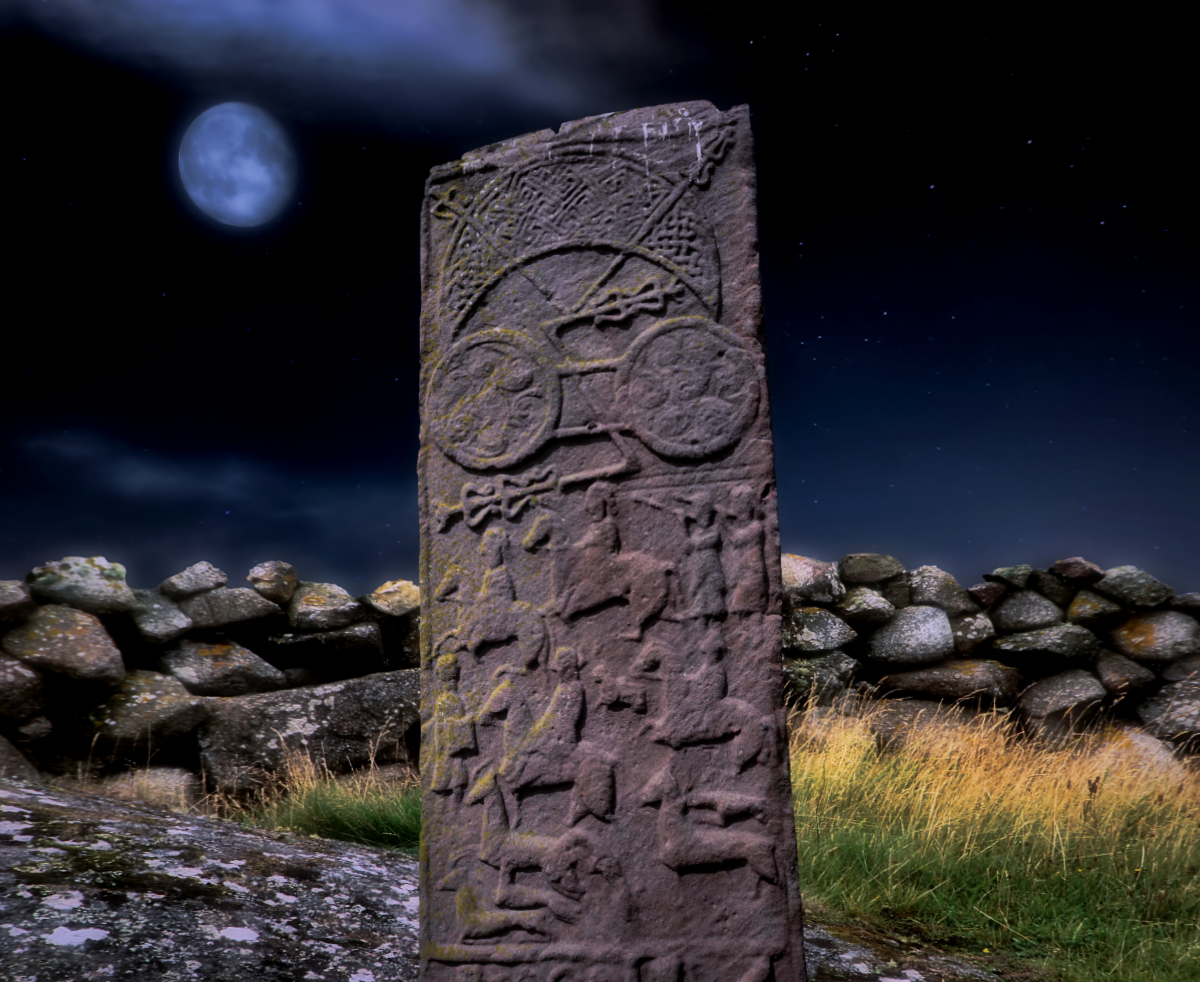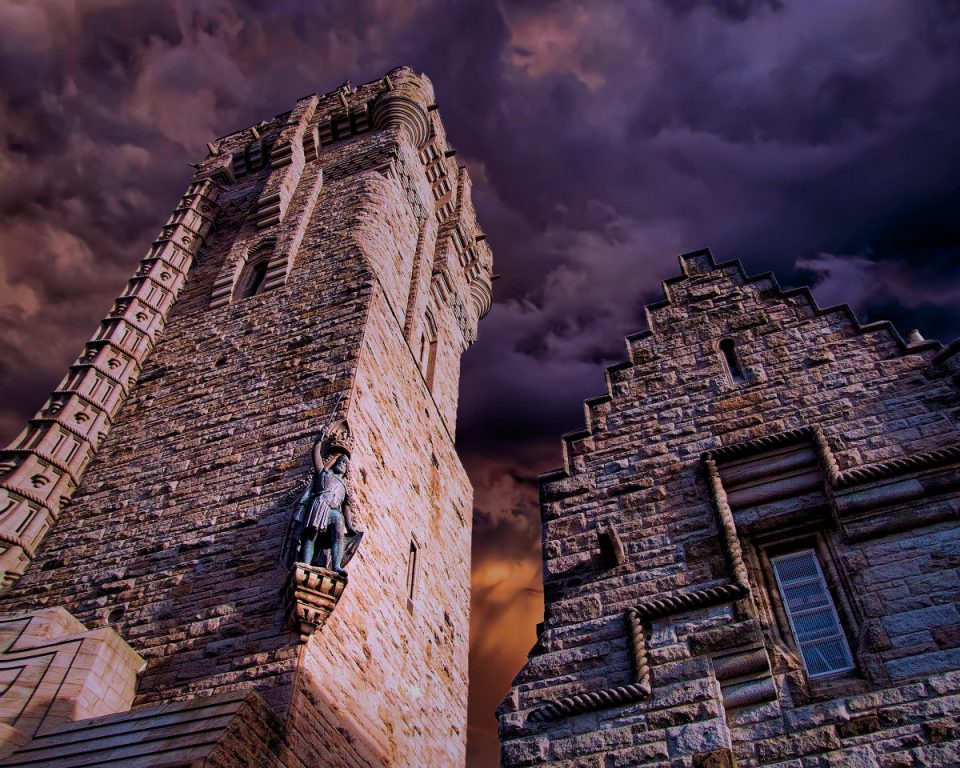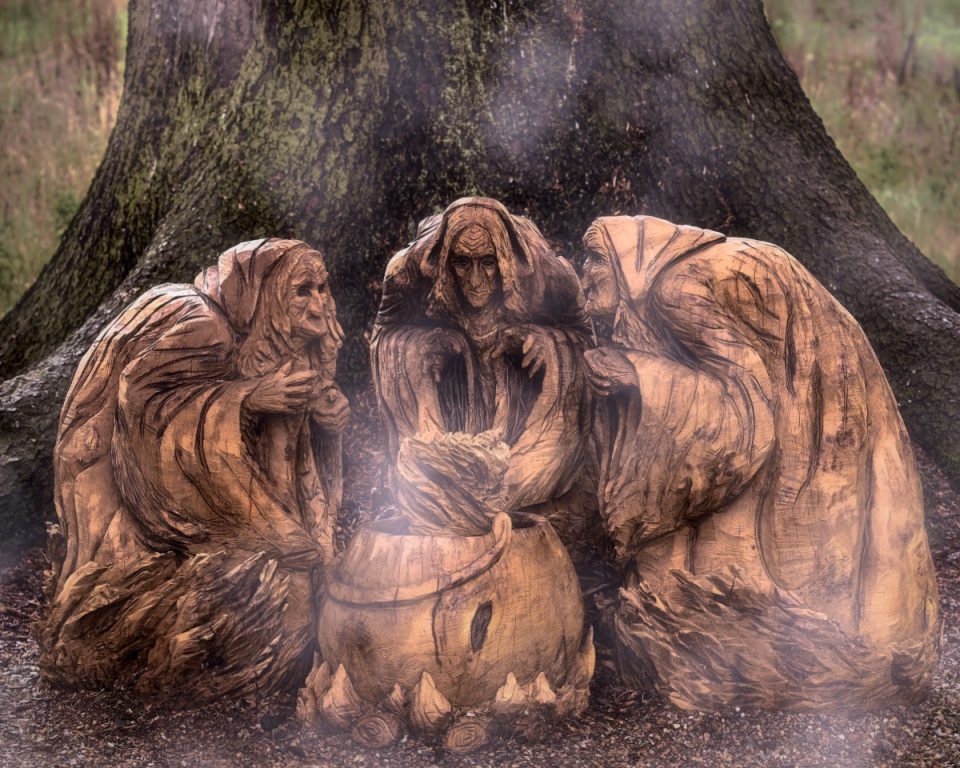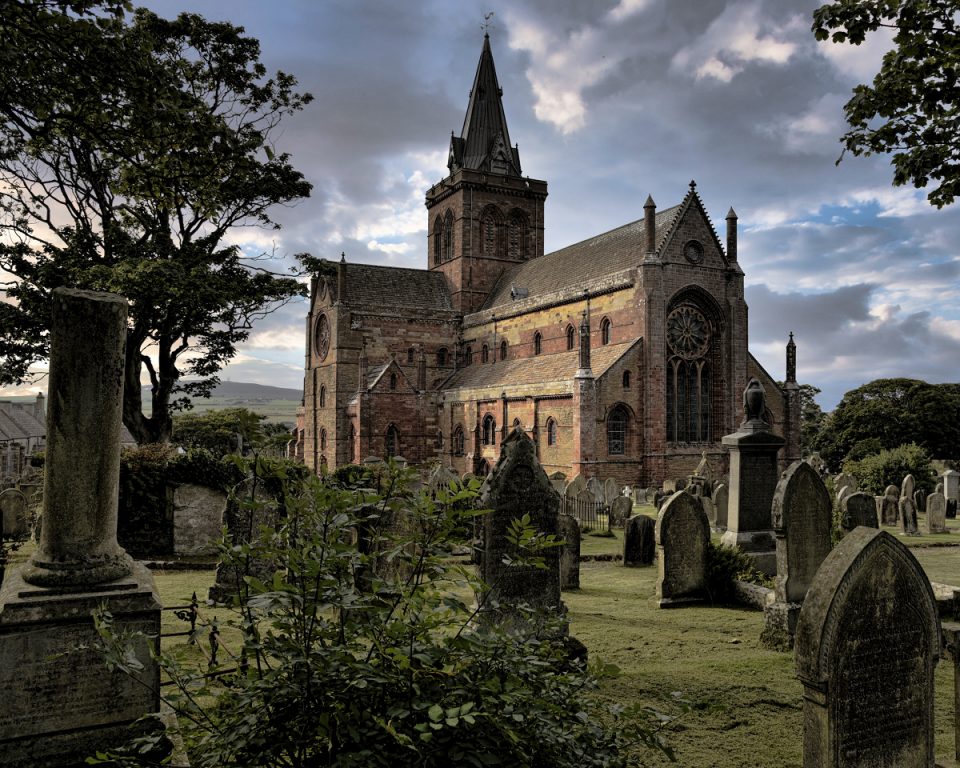As the Battle of Dún Nechtain was taking place, a strange incident occurred in Carlisle. Iurminburg, Queen of Bernicia, sought refuge in a Nunnery which her sister governed as Abbess. Where else was a woman supposed to find solace when their menfolk were at war? That day she had a visitor, the recently appointed Bishop of Lindisfarne, Saint Cuthbert. Cuthbert it seems was blessed-or- cursed with the Second Sight.
Bereft of their men, the atmosphere amongst the women was unbearably tense and so Cuthbert was relieved to be taken on a tour of the local Roman antiquities by one of the royal officials. As the three o’clock bell rang, he became anxious and lifted his eyes to the sky.
“Oh, oh, oh!” he declared. “I believe that war has ended and the verdict has been against our warriors.
Immediately he rushed off to prepare the queen for the worst. Within a few days, their gravest fears were realised. One of the few survivors staggered through the gates of Carlisle with the dreaded news. King Ecgfirth, King of Bernicia was dead!
Perhaps Cuthbert chided himself for not trying a little harder to persuade his liege lord from pursuing this folly but, bold and belligerent, Ecgfirth was not a man to take advice easily.
The Background to the Battle of Dun Nechtain
Very little is known about the Battle of Dún Nechtain. Most of what we do know is gleaned from the writings of Irish and Brittonic priests and that of the Venerable Bede, who penned his remarks some fifty years later. The Battle is known by several different names, each giving a clue to the battle’s possible location. To the English, it was the Battle of Nechtanesmere (Nechtan’s Lake) and to the Welsh it was known as Gueith Linn Garan (The Battle of the Pool of the Heron). We know it took place on the 20th of May 685 A.D. at 3 pm.
Alas, this little heard of battle has been reduced to a mere whisper in the annals of history. Yet the significance of this battle cannot be underestimated. Had the Pictish masses not been victorious, the nation we now know as Scotland, could never have come into existence. The peoples of Pictland, Dal Riata and the Alt Clut or the Britons of Strathclyde quite possibly might have been swamped by the ever-expanding kingdom of Bernicia and later been incorporated into ‘Angle-land’.
So much rested on the outcome of this battle and yet we know so little about it. Why would two cousins war against each other? Where was the battle fought? Which part of Pictland did the Fortrui Picts come from? How many souls lost their lives on that fateful day? Why would the Picts carry their enemy’s body to the sacred Isle of Iona for burial? These are questions we may never know the answer to.
Ecgfirth and the road to Dún Nechtain
Queen Iurminburg’s husband was Ecgfirth. His Angle forebears were descended from Germanic tribes who had settled in England from the mid-5th Century onwards and subsequently rose to become the ruling classes. They had spread northward, conquering the Gododdin, the ancient people who had once inhabited the lands south of the River Forth, including Din Eidyn or Edinburgh as it is now called. By the time he inherited the Kingdom of Bernicia or Northumbria, his late father Oswui, had subjugated the Mercians in the south and he had hegemony over the Picts, Dal Riatans and the Strathclyde Britons in the North.
Then in 679 A.D., Ecgfrith clashed with the Mercians in the Battle of Trent. It was more of a standoff than the decisive battle he had hoped for. Perhaps he needed to save face, for what he did next went against all the counsel of his advisors. He invaded Ireland. It was brutal. Churches and monasteries were looted, fellow Christians killed, and he returned with a great bounty in slaves and silver. It left a bad taste in the mouths of the clerics who served in his court. Justice needed to be satisfied
The following year his eyes looked northward. The Picts were now a thriving people with trade lines reaching across Europe and their fertile plains were proving to be the bread bin of the North. Once more he was advised against his decision. Once more the strong-willed overlord refused to listen. This time he would march against the Picts.
Who were the Picts?
Part of the allure of the Picts is that they are a people shrouded by mystery. Their writings have longs since gone, their culture swamped by their Celtic neighbours, the Gaelic speaking Dal Riatan Scots. Their language has all but vanished with only fragments remaining in the place names of the north and east of Scotland. The Romans referred to them as the Picti, the painted people, with a warrior caste who allegedly fought naked in battle.
But the Picts were not primitives. They were amazing artisans, skilled in both stone and in the use of metal. They have left an amazing legacy in carved stones and silver brooches. Their old Gods are unknown for they had forsaken their old religion and converted to Christianity. Much of what we know about this people comes from the writings of others or from the iconographic record left on their numerous decorated stone cross-slabs.
The Rise of Bridei mac Bili
The Picts of Fortrui were led by Bridei mac Bili. His father appears to have been King of Alt Clut and therefore from the British Kingdom of Strathclyde but Bridei’s grandfather was Nechtan, of Fortrui and therefore a Pict. His mother was a Deiran from Northumbria. This Bridei had the blood of most of the important royal dynasties in the north, coursing through his veins. Ecgfrith would have been his cousin. Indeed, the two men may have known each other personally as young men and it is possible that Bridei initially relied on upon the patronage of Northumbria to secure his hold in Fortrui.
Bridei was a man on the rise. As a successful war leader in the North, he was driven by an agenda of expansionism. Dunottar was besieged in 680, Orkney in 681 and Dundurn in Strathearn in 682. Emboldened, did the Pictish leader refuse to pay any more tribute to his cousin or did Ecgfirth feel that threatened by his cousin’s rise in power?
We will never know.
Original Writings about the Battle of Dún Nechtain
We have four sources of information about the Battle of Dún Nechtain.
According to Bede:
“Indeed the very next year the king rashly took an army to ravage the land of the Picts, against the urgent advice of his friends and particularly of Cuthbert, of blessed memory, who had recently been made a bishop. The enemy feigned flight and lured the king into some narrow passes in the midst of inaccessible mountains; there he was killed with the greater part of the forces he had taken with him, in the fortieth year of his age, the fifteenth year of his reign on the twentieth of May. As I have said, his friends urged him not to attack the Irish who had done him no harm; and the punishment for his sin was that he would not now listen to those who sought to save him from his own destruction.”
In the Annals of Ulster we read:
“The battle of Dún Nechtain on the 20th of May, a Saturday, that is, in which Ecgfrith son of Oswiu, king of the English, having completed the fifteenth year of his reign, was slain with a great body of his soldiers.”
In the Annals of the Tigernach we read:
“The battle of Dún Nechtain was carried out on the twentieth day of the month of May, a Sunday, in which Ecfrith son of Osu, king of the Saxons, in the 15th year of his rule completed, with magna caterua of his soldiers was killed by Bruide son of Bile king of Fortriu.”
In Nennius’ account from the Historia Brittonum we discover:
“Egfrid is he who made war against his cousin Brudei, king of the Picts, and he fell therein with all the strength of his army and the Picts with their king gained the victory; and the Saxons never again reduced the Picts so as to exact tribute from them. Since the time of this war it is called Gueith Lin Garan.”
What we know about the Battle of Dún Nechtain
From this we can glean that the Battle must have taken place near a Fort (or Dun) known as Dun Nechtain, there were high inaccessible mountains with narrow passes in the vicinity and the battle took place near a loch. Lin Garan means Pool of the Heron.
The Traditional Site of the Battle of Dún Nechtain
In 1807 George Chalmers noted in his book ‘Caledonia’ that Dunnichen, near Forfar was recorded in the early charters of Arbroath Abbey as Dun Nechtain. He concluded that the nearby Dunnichen Moss must, therefore, be Lin Garan, the Pool of the Heron, and that Dunnichen Hill had to be the site of a hill fort! The criteria had been met- this was surely the site of the battle. Then there were the Pictish Stones at nearby Aberlemno. One stone contains a battle scene with a group of warriors wearing what superficially looks like coppergate helmets, the kind of helmets worn by Anglo-Saxon Warriors. However, the stone dates to a later time period and may represent a Viking Incursion or even a Biblical story.
However, there is one aspect of Dunnichen which does not meet Bede’s description. He states, “The enemy feigned flight and lured the king into some narrow passes in the midst of inaccessible mountains; there he was killed.”
The hills in the surrounding area are scarcely ‘inaccessible mountains’ particularly given that Bede’s raconteurs were mountain men familiar with the heights of the Cheviots, the Lammermuirs and the North Pennines. Moreover, what has been cited as the nearby Dun is categorised as highly dubious in Historic Environment Scotland’s Canmore Database.
An Alternative Site for the Battle of Dún Nechtain
Until 2006, Dunnichen’s claim to be the site of the battle of 685 was largely accepted by historians. However, an article by Alex Woolf in that year offered an alternative site for the battle at Dunachton, on the north-western shore of Loch Insh in Badenoch. Key to his argument is the presence of large mountains with passes. Five mountain passes converge in the area: Glen Feshie, Glen Tromie and Glen Trium and the two watercourses of Loch Laggan and Loch Ericht. Dunachton does have a position near a mere – Loch Insh – and is associated with a dún site on a hill, while the surrounding terrain is difficult.
However, once again, the evidence is circumstantial. There is no definitive proof that the battle took place here. In addition, it also seems a strange place for the Fortrui Picts to engage in battle if we assume that they come from what has been the traditionally accepted home of the Fortrui Picts.
The Traditional Location of the Fortrui Picts
Traditionally it was assumed that Fortrui Picts lived in the Strathearn and Monteith Area of Perthshire. This has been based on the following two extracts. The first comes from the ‘Chronicles of the Kings of Alba’ and states:
“Causantín mac Aeda held the kingdom forty years. In his third year the Northmen plundered Dunkeld and all Albania. The very next year the Northmen were slain in Sraith Herenn.”
In the Annals of Ulster we read:
“Ímar grandson of Ímar was killed by the men of Fortriu, and many were slain about him.”
The Re-location of the Fortrui Picts
The implication is that Ímar and his men were the Norse men mentioned in the earlier quote and that Sraith Herenn as in the area governed by the Fortrui Picts. However, that is assuming Sraith Hernn is the same as the Strathearn we know today.
Woolf wrote:
“It is also not absolutely clear where ‘Sraith Herenn’was. Philologically it is probably Srath Éireann but there are at least two places in Scotland with this name. In Perthshire, as Skene noted, there is Strathearn; but north of the Mounth Strathdearn, the valley of the Findhorn, the ‘White Earn’, bears this name: that this river was also known simply as the Earn is confirmed by the place-name ‘Invererne’ at the mouth of the river just north of Forres …The battle in Srath Éireann may, then, have taken place either north or south of the Mounth and either in or outwith the territory of the men of Fortriu. Skene’s equation of Fortriu with Strathearn and Menteith seems far from secure.”
Not only does it make it more likely that the Fortrui Picts were from Moray and therefore more likely to be leading Ecgfirth through the mountain passes of the Cairngorms into a trap but it gives Bridei access to a large naval port.
Access to a Pictish Port
Burghead is home to what has to be the largest Pictish fort known. It is three times larger than the next comparative fort. At the site of the Pictish Fort, a huge inlet of sea cut through the coast next to Burghead. Further along the coast, there was another sea loch known as Loch Spynie. A huge bog was likely to have existed between the two inlets. This would have made Burghead virtually an island and a very defensive place with safe harbourage in the Moray Firth. This would have given Brideii the boats he would have needed for his campaigns at Dunnotter and on Orkney.
The Fort was known to be decorated with carvings of bulls. Today a ritualised fire festival still takes place today, several days after New Year, possibly remnants of a ritual performed by their early ancestors. There is a sacred well in the town which predates Christianity. Further along the coast, on the same ‘island’ strand, there is a tidal cave called Sculptor’s Cave. It is filled with ancient human bones and Pictish Icons. It is believed that ritual sacrifice took place here. The vast amount of archaeological evidence recovered from area and nearby places like Rhynie, suggest that the Picts in the North were not the poor distant cousins of the Southern Picts but the main drivers of Pictish politics and governance.
The Demise of Ecgfirth
An Irish monk probably based at the great monastery of Bangor in Ireland composed a poem about the battle. He described Ecgfrith’s demise with grim satisfaction seeing the Pictish victory as God’s punishment for the brutal Northumbrian raid on Brega in 684:
‘Today Bridei gives battle
over the land of his grandfather,
unless it is the wish of the Son of God
that restitution be made.
Today the son of Oswiu is slain
in battle against iron swords.
Even though he did penance,
it was penance too late.
Today the son of Oswiu is slain,
he who took the black draughts.
Christ has heard our prayer
that Bridei would avenge Brega.’
The Aftermath of the Battle of Dún Nechtain
However, there is an old Northumbrian tradition, written in a chronicle in the 1100s which states that Ecgfirth was defeated and slain
‘ at Nechtanesmere, which is the Lake of Nechtan, on the 20th of May in the fifteenth year of his reign. His body was buried on Iona, the island of Columba.’
It seems that the dead King was not left on the battlefield to be devoured by wolves and ravens but carried away by the Pictish victors to be buried with honour in the most hallowed of places within the Celtic church.
The Pictish victory strengthened the men of Fortrui’s place within the Pictish Powerhouse. Bridei’s battlefield triumph was evidence of his legitimate claim to the overlordship of the lands between Dunottar and Dundurn. Thus Bridei was able to extend his authority over the ‘innumerable nations’ of the Picts in the lowlands. By the time Bede wrote his Historia in the 730s, Pictland was considered to be a single kingdom. The emergence of a single kingdom of the Picts is a direct result of the victory in 685 and the most significant outcome of the Battle of Dún Nechtain.
Please feel free to share the spooky by using the links below or leave us a message in the comments box.




